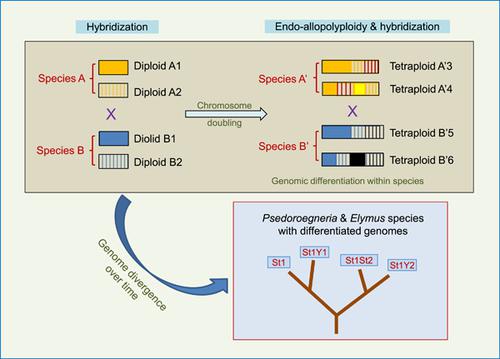当前位置:
X-MOL 学术
›
J. Syst. Evol.
›
论文详情
Our official English website, www.x-mol.net, welcomes your feedback! (Note: you will need to create a separate account there.)
Endo-allopolyploidy of autopolyploids and recurrent hybridization—A possible mechanism to explain the unresolved Y-genome donor in polyploid Elymus species (Triticeae: Poaceae)
Journal of Systematics and Evolution ( IF 3.7 ) Pub Date : 2020-07-11 , DOI: 10.1111/jse.12659 Quan‐Lan Liu 1 , Lu Liu 1 , Song Ge 2 , Li‐Ping Fu 1 , Shi‐Qie Bai 3 , Xin Lv 1 , Qian‐Kun Wang 1 , Wang Chen 1 , Fan‐Ye Wang 1 , Li‐Hong Wang 1 , Xue‐Bing Yan 4 , Bao‐Rong Lu 5
Journal of Systematics and Evolution ( IF 3.7 ) Pub Date : 2020-07-11 , DOI: 10.1111/jse.12659 Quan‐Lan Liu 1 , Lu Liu 1 , Song Ge 2 , Li‐Ping Fu 1 , Shi‐Qie Bai 3 , Xin Lv 1 , Qian‐Kun Wang 1 , Wang Chen 1 , Fan‐Ye Wang 1 , Li‐Hong Wang 1 , Xue‐Bing Yan 4 , Bao‐Rong Lu 5
Affiliation

|
The genus Elymus L. in the tribe Triticeae (Poaceae) includes economically and ecologically important forage grasses. The genus contains the pivotal St genome from Pseudoroegneria in combination with other genomes in the tribe. Many Elymus species are tetraploids containing the StY genomes. It is thought that polyploidization characterizes the speciation of the genus in which the Y is considered as another key genome. Based on data from cytological, genome in situ hybridization, and molecular studies, we hypothesized an endo-allopolyploidy origin of the StY-genome species from the autotetraploid Pseudoroegneria species. To test this hypothesis, we amplified, cloned, and sequenced five single-copy nuclear genes (i.e., alcohol dehydrogenase 1–3, Adh1–Adh3, RNA polymerase II, Rpb2; and Waxy) from Elymus, Pseudoroegneria, and Hordeum species. The phylogenetic trees constructed based on the sequencing analyses of all genes indicated that diploid and autotetraploid Pseudoroegneria species were closely related, although with considerable genetic variation in tetraploids. In addition, the StY-genome Elymus species tended to have a close relationship with the diploid and autotetraploid Pseudoroegneria species, although different phylogenetic relationships among the gene trees were detected. These results indicated that the StY-genome species may have an autotetraploid origin and experienced recurrent hybridization. The complex St genomes in Pseudoroegneria in the polyploid state may gain more opportunities for within-species differentiation and recurrent hybridization. As a result, series modified versions of St genomes evolved into the StY genomes in some Elymus species.
中文翻译:

同源多倍体的内异源多倍体和反复杂交——解释多倍体 Elymus 物种中未解决的 Y 基因组供体的可能机制(小麦科:禾本科)
Triticeae(禾本科)部落的Elymus L.属包括经济和生态上重要的牧草。该属包含来自Pseudoroegneria的关键 St 基因组以及该部落中的其他基因组。许多Elymus物种是含有 StY 基因组的四倍体。人们认为,多倍化表征了 Y 被认为是另一个关键基因组的属的物种形成。基于来自细胞学、基因组原位杂交和分子研究的数据,我们假设来自同源四倍体Pseudoroegneria的 StY 基因组物种的内异源多倍体起源物种。为了验证这一假设,我们从Elymus、Pseudoroegneria和Hordeum物种中扩增、克隆和测序了五个单拷贝核基因(即乙醇脱氢酶 1-3、Adh1-Adh3、RNA 聚合酶 II、Rpb2和Waxy )。基于所有基因的测序分析构建的系统发育树表明,二倍体和同源四倍体Pseudoroegneria物种密切相关,尽管在四倍体中具有相当大的遗传变异。此外,StY 基因组Elymus物种往往与二倍体和同源四倍体Pseudoroegneria 有密切关系种,尽管在基因树之间检测到不同的系统发育关系。这些结果表明 StY 基因组物种可能具有同源四倍体起源并经历了反复杂交。多倍体状态的假单胞菌中复杂的 St 基因组可能获得更多的种内分化和反复杂交的机会。结果,在一些Elymus物种中,St 基因组的系列修改版本演变成 StY 基因组。
更新日期:2020-07-11
中文翻译:

同源多倍体的内异源多倍体和反复杂交——解释多倍体 Elymus 物种中未解决的 Y 基因组供体的可能机制(小麦科:禾本科)
Triticeae(禾本科)部落的Elymus L.属包括经济和生态上重要的牧草。该属包含来自Pseudoroegneria的关键 St 基因组以及该部落中的其他基因组。许多Elymus物种是含有 StY 基因组的四倍体。人们认为,多倍化表征了 Y 被认为是另一个关键基因组的属的物种形成。基于来自细胞学、基因组原位杂交和分子研究的数据,我们假设来自同源四倍体Pseudoroegneria的 StY 基因组物种的内异源多倍体起源物种。为了验证这一假设,我们从Elymus、Pseudoroegneria和Hordeum物种中扩增、克隆和测序了五个单拷贝核基因(即乙醇脱氢酶 1-3、Adh1-Adh3、RNA 聚合酶 II、Rpb2和Waxy )。基于所有基因的测序分析构建的系统发育树表明,二倍体和同源四倍体Pseudoroegneria物种密切相关,尽管在四倍体中具有相当大的遗传变异。此外,StY 基因组Elymus物种往往与二倍体和同源四倍体Pseudoroegneria 有密切关系种,尽管在基因树之间检测到不同的系统发育关系。这些结果表明 StY 基因组物种可能具有同源四倍体起源并经历了反复杂交。多倍体状态的假单胞菌中复杂的 St 基因组可能获得更多的种内分化和反复杂交的机会。结果,在一些Elymus物种中,St 基因组的系列修改版本演变成 StY 基因组。



























 京公网安备 11010802027423号
京公网安备 11010802027423号